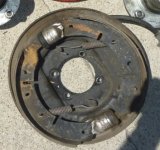BN6_2197
Jedi Trainee
Offline
Hi all,
I am loosing break fluid in my front brake. I removed the brake drum and saw that the sealing of one of the cylinders is defect. I now want to remove the cylinder and repair it. Any hints on the removal procedure? It it my first time I am doing this and I did not find the right information in the workshop manual.
Cheers,
Volker
I am loosing break fluid in my front brake. I removed the brake drum and saw that the sealing of one of the cylinders is defect. I now want to remove the cylinder and repair it. Any hints on the removal procedure? It it my first time I am doing this and I did not find the right information in the workshop manual.
Cheers,
Volker

 Hi Guest!
Hi Guest!

 smilie in place of the real @
smilie in place of the real @
 Pretty Please - add it to our Events forum(s) and add to the calendar! >>
Pretty Please - add it to our Events forum(s) and add to the calendar! >> 

